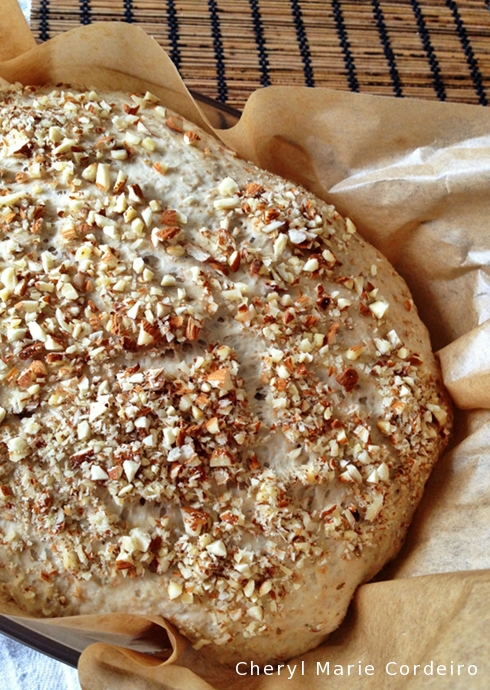
The evening’s bake – mixed grain loaf topped with chopped almonds.
Text & Photo © CM Cordeiro 2013

The evening’s bake – mixed grain loaf topped with chopped almonds.
Text & Photo © CM Cordeiro 2013

The art of apple crumble.
To the sounds of Fact Magazine Sven Weisemann Tikuma.
Text & Photo © CM Cordeiro 2013
LUNCH TALK
$E: yeah / i totally understand why it is that women tend to fall for the bad guys / [1 guys with an attitude]1
$L: [1 you’re really attracted]1 to these types because there{s} so much danger surrounding them / so much machoism that you as a [2 woman / don’t]2
$E: [2 don’t have // yep]2 it{i}s so completely opposite of being female right
$L: < yep > and opposites attract
@ < ingressive >
$M: cliché / cliché // < but > / i completely understand if girls fall for devil type guys / plenty < of us do that / but this is beyond ridiculous >
@ < hesitation >
@ < laughter: E and L >
$T: makes it harder when lucifer has an angelic [3 smile too / right]3
$M:[3 angelic smile]3 / you{a}re talking he{ha}s got < a code of conduct / a moral compass >
@ < laughter: all >
$T: tough // [4 but]4
$M: < [4 yep]4 >
@ < ingressive >
$L: < > you gonna finish that ice-cream / can i have it
@ < gesture: looks at M's dessert plate >
$M: < nope >
@ < ingressive >
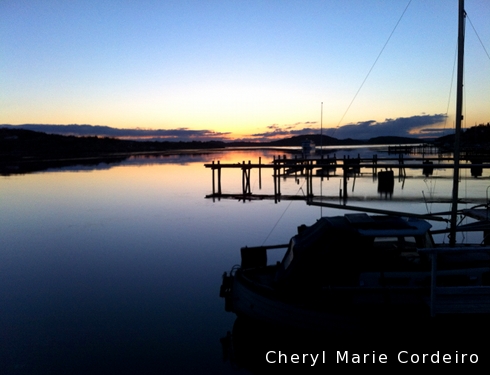
Swedish west coast. Dawn.
Text & Photo © CM Cordeiro 2013
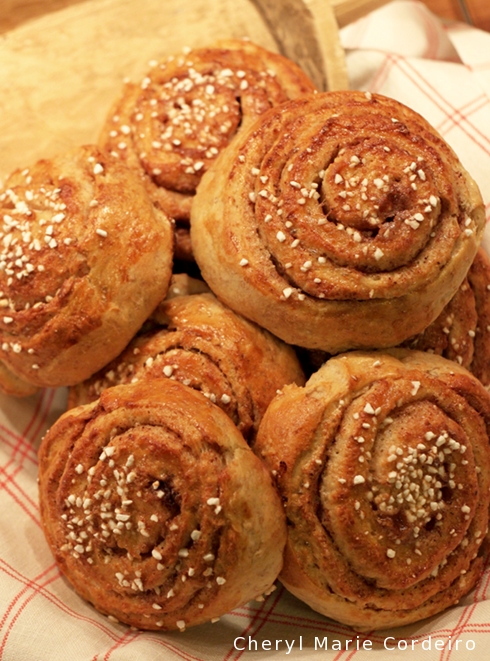
Cinnamon rolls, well loved at Swedish fika sessions.
Text © JE Nilsson, CM Cordeiro 2013
It is usually around the small gatherings along corridors and the Swedish fika or coffee sessions that you’ll get a chance to candidly exchange ideas. Today’s fika sessions revolved around puntarella salads, a salad that I would never have discovered before today and might never have if one of us did not walk in with a delicious looking light garlic and anchovies infused box of puntarella leaves.
§1: so what else goes into this salad
§2: i don’t know / just found this yesterday / looked up the internet for a recipe [and i have it here today]
§3: [you don’t know] // but that’s very swedish isn’t it / to not know things / or / not know everything
[@all: laughter]
§4: but we have the structures in place / and that’s pretty solid
§2: think of us like a big ship / slow steering / but most certainly going somewhere // and there are many captains
§5: too many captains sometimes / and some not knowing the structures
[@all: laughter]
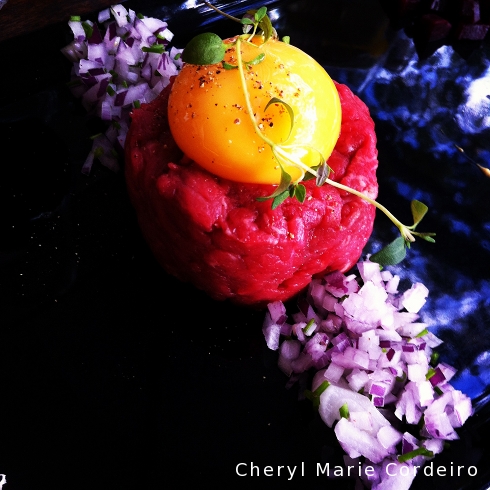
Beef tartare at Dinner 22.
Text © JE Nilsson, CM Cordeiro 2013
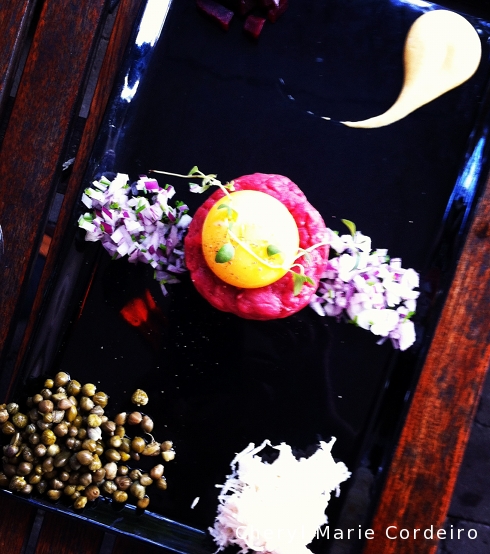
Dinner 22 gets its name from being located at Södravägen 22, Gothenburg, Sweden.
This restaurant and bar offers a cozy dining space for the evenings, with an impressive list of wines. Their desserts are just as decadent and luscious to the palate, their dark chocolate parfait being my favourite on their list.
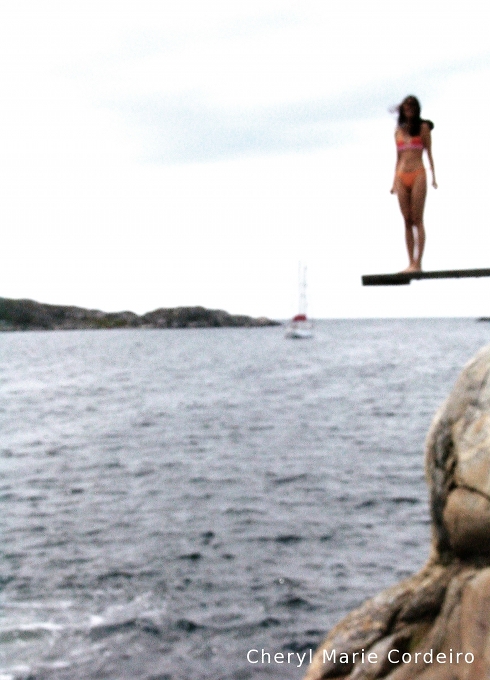
At the diving board, along the Swedish west coast.
It seemed I stood there for the longest time. In the wind.
Text & Photo © JE Nilsson, CM Cordeiro 2002 and 2013
This series of pictures were taken in the first summer that I was here in Sweden in 2002 and just before my very first swim in the North Sea, and just about my last too.
The average temperature of the waters in the North Sea in summer is 17°C (63°F) and 6°C (43°F) in the winter. I believe on this occasion it was a reported cozy 18°C. I much prefer if waters were a tepid 26°C, like those along the East Coast of Singapore or pick any white sanded beaches of the tropics from Langkawi to Bali.
The winter months see frequent gales and storms along the Swedish west coast, and apparently on this occasion, it was the usual windy – and cold.
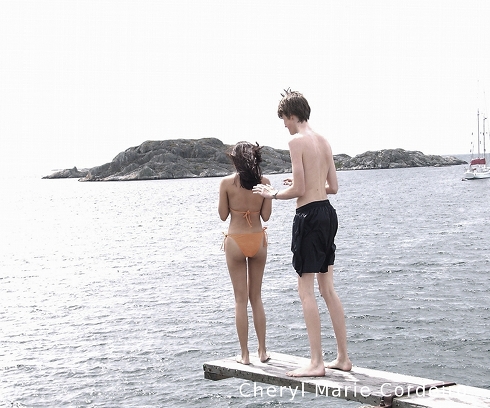
Just before the push. It seemed I needed some encouragement.
Else, I was just taking too much time on the plank.
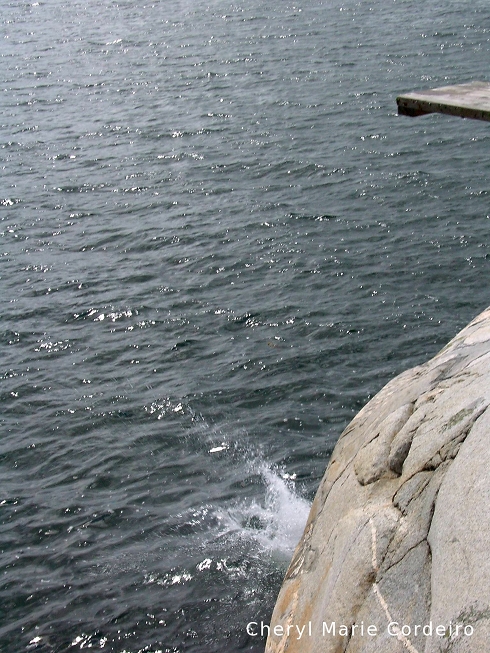
I think I saw the sea come rushing right up at me. No time for further thoughts!

Photo: Kent Hallgren.
The Swedish East Indiaman Gotheborg III in GP 11 April 2013.
Text © JE Nilsson, CM Cordeiro 2013
Though I’ve been in Sweden for just about a decade, I wonder if it is only I who have grown tired at the consistent gloomy headlines of the local Swedish newspapers when writing about the Swedish East Indiaman Gotheborg III, the latest headlines reading – No more sailing for the East Indiaman.
I wonder if this sensationalization of headlines is but a low end marketing attempt to attract readership since there is a general consensus of the ship itself being an entity of high interest. But what these pessimistic headlines reflect however, is a probable trend of lack of confidence in what is considered a good investment for the city of Gothenburg, and a business opportunity that can generate great dividends to all.
The Swedish East Indiaman Gotheborg III cannot help but be a symbol of the international harbour city of Gothenburg, with its rich history of daring merchants traveling the world, establishing global companies and one that have since long twinned its future with cities like Shanghai in China.
That the ship could do with more money is nothing new. What we need to bear in mind though, is that money does not create ideas. It is ideas that create money.
That the ship should be made into a museum even after 2020 without consideration of its larger context would be shortsighted planning and a terrible waste of resources. An East Indiaman ship museum would immediately be compared to the Vasa museum in Stockholm by visitors who know little of the East Indiaman history, compared to the Vasa which has become a monument over time, and a prime example of publicly funded projects.
Ironically, the Vasa was too large, too unstable, catering to prestige rather than function, built to government specification, managed by bureaucrats and naturally sank just minutes after being launched, already in 1628.
The East Indiaman Gotheborg III was founded on a different heritage and set of values that in turn rendered a fully functioning sailing vessel that looks her most glorious when sailing in the open seas.

Photo: Jakob Rempe.
The Swedish East Indiaman Gotheborg III in its Europe Tour 2013, Leg 1 at sea.
The first East Indiaman Gotheborg came within viewing distance of its home harbour before she hit a rock and sank in 1745. The Gotheborg II foundered outside of Cape Town in South Africa in 1796, and the Gotheborg III made it all the way back home in 2007. This is the true entrepreneurial spirit of the ship, one that does not take a complete failure as a no, but just go for it again since it is the right thing to do, no matter!
Based on such authenticity and integrity, what benefits would anyone reap by turning the Gotheborg III into a museum that would still only be a country side mock-up version of the Vasa?
Tracing the journals that people keep about her, the documentaries and personal experiences of the crew onboard, the Gotheborg III is happiest when she has her people around her, who revel in learning from handling her ropes, her masts and her spirit of freedom.
Waters have more often than not united than divided, and the means for that are the ships – virtual or real. With this general enthusiasm and love for her comes the immense international goodwill for Gothenburg and Sweden set against the background of an increasingly polarized and fragmented EU.
China for example, doesn’t know much about Sweden as a country, but they know about the unique gesture of friendship that the entire project around the creation and sailing of the Gotheborg III was and still is.
While Stockholm might be the administrative heart of Sweden, the city of Gothenburg have always been the port city, with the complementary role of looking out into the world, with its international portfolio of shipping and trade.
As a testament to the entrepreneurial spirit of the city of Gothenburg, in 2011, Anneli Hulthén the Mayor of Gothenburg, received the award Entrepreneur for the World in the politicians’ category at the World Entrepreneurship Forum in Singapore.
The building of the Swedish East Indiaman Gotheborg III began as an entrepreneurial effort with a clear purpose of trade and cultural exchange. There is no reason why it should not be kept true to its entrepreneurial roots. That is were she began and that is where she belongs. Even as business climates change over the years, Gothenburg is still where such business giants such as SKF and Volvo AB were born.
That the City of Gothenburg would stop sponsoring the Gotheborg III is not the same thing as that the ship would need to stop sailing. On the contrary. Gothenburg and West Sweden must see itself in an international context where bringing in business and work opportunities is a prime concern, and to not see the potential in using the Swedish East Indiaman Gotheborg III to its very purpose to which she was built, one could argue, is not very clever.
As a first step towards an integrated perspective of the future of the Gotheborg III, the true history of the ship – as being a private venture started by entrepreneurs, needs to be understood – in order for it to fully leverage its goodwill capacities.
The ship also needs to be run in such a way that other entrepreneurs are encouraged to flock around her so as to also leverage the platform of opportunities that she offers.
What is needed is not lamenting the constant lack of money, but rather the realization that there are no ‘costs’. A sponsorship or a business agreement is just an investment that when properly put to work pays huge dividends to Gothenburg, to western Sweden, to Sweden as a whole, and to an ever fragmenting Europe that needs everything it has to keep itself together.
If something, it is time that the East Indiaman Gotheborg III should be placed in the hands of those who can see and do anything with the larger context. One that goes beyond Gothenburg and of Sweden and is in line with for example the European Commission’s Europe 2020 Flagship Initiatives for ‘Smart Growth, Sustainable Growth and Inclusive Growth’.
Seen in that perspective, the Gotheborg III though a small piece in the overall picture of things, is much needed. And she is needed, alive and sailing!
As such, the open sea is where the Gotheborg III belongs, where she is more valuable as a sailing vessel than as a museum, beyond 2020.
Homemade egg noodles / pasta served with meat sauce, topped with thyme
and a drizzle of extra virgin olive oil from Italy.
Text and Photo © JE Nilsson, CM Cordeiro 2013
A fork full of this homemade egg noodles / pasta brought an instant flash of a Madeleine moment of sorts where I was reminded of my first encounters with egg noodles as a child of about age six.
It would be one of my first days in school in Primary One at CHIJ Katong in Singapore, dressed in freshly pressed blue pinafore over a starched collar white blouse. I was new to the routine of going to class, making new friends and having to navigate recess time buying food at the school canteen on my own. It was perhaps the second day of school that I found myself drawn to one of the more crowded canteen stalls that sold fishball noodles that cost all of Singapore $0.40 cents during the early 1980s. I realize today that the bowl that was filled half with noodles and two fishballs, was not large though it seemed at the time, very large in my tiny hands.
I’ve always found myself to be a slow learner and remember that at age six, while some other girls had mastered the art of eating with chopsticks, I sat for most part of the recess time, struggling to put strands of noodles onto the soup spoon for a neat consumption. It took time and I was happy that on some days, my father’s father was around to keep me company, sometimes laughing at my actions, most times just sitting and watching in amusement. Continue reading “Homemade egg noodles / pasta in under an hour” →
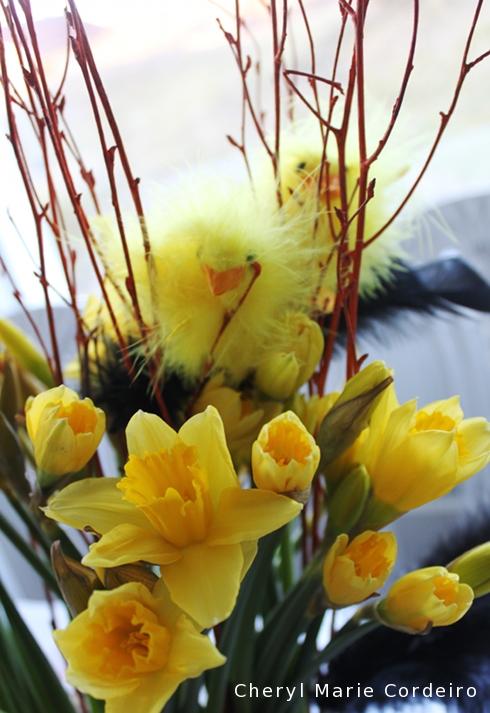
Easter lilies.
Yellow is the colour that distinctly marks Easter in Sweden, together with the colourful Påsk or Easter Egg.
Text and Photo © JE Nilsson, CM Cordeiro 2013
In Sweden, which is today seen as a very secular country, Easter is still a celebration that is much anticipated however not so much for the religious connotations as for it being a landmark weekend for the upcoming summer and a sign, that from now on, its spring. Continue reading “Easter “Påsk” yellow 2013″ →

Feeling bohème in a light spring breeze, March, Swedish west coast, 2013.
In a cashmere top, made in Japan, and silk-mix dress, made in Italy.
A belt with two long strands of cultured pearls bound as one, in light pink to deep purple lustre.
Text and Photo © JE Nilsson, CM Cordeiro 2013
As the earth turns on its axis, the Land of the Midnight Sun is awakening to spring at a cozy -4 to 1 centigrade outdoors. Not warm by any standards but sunlight is here to stay for the next few months in a stretching of daylight.
The colour yellow marks Easter in Sweden, as red marks Christmas. And while in previous years, Easter decorations on tables consisted of the sunshine marigold of Easter Lilies with likewise colourful feathers and eggs, the symbols of the spring equinox, of new beginnings and fertility, this year in shops – black feathers – that were fetching enough for me to bring home where they immediately found a place on the dining table together with the bright Easter lilies.
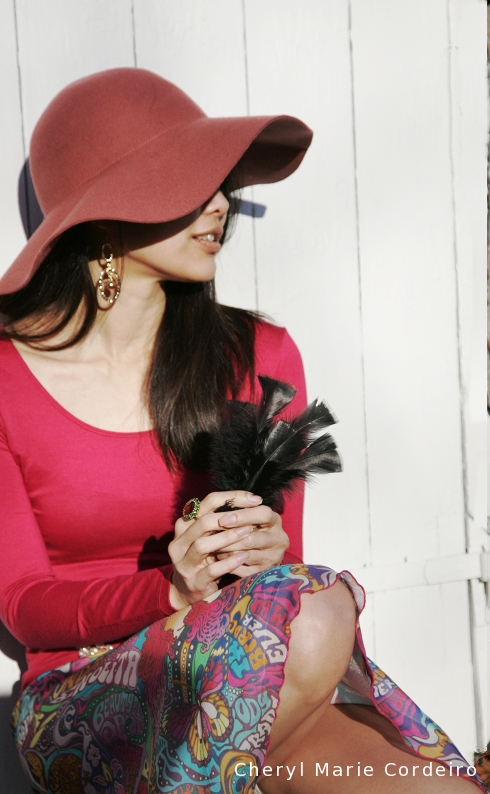
Black feathers, available at the florists, find their way to interior decoration in Sweden this year at Easter.
On Swedish tables this Easter weekend would be piscatorial staples such as sill, herring and anchovies in the form of Janssons Frestelse (Janssons Temptation), a potato gratin laced with heavy cream, sauteed onions and anchovies.
And eggs.
Apart from the moulded bacon and eggs dish I’ve prepared, I would love spending exquisite time exploring some of the more delectable looking egg recipes. Softly poached and creamy to the palate, Eggs Benedict makes it high on the breakfast list and Shakshuka on the lunch list.
Cooking is as therapeutic as it is an adventure to the senses. Poached eggs are not always easy to prepare to perfection, but I figure after some experimenting, I might finally get it right.

With a not too impressive zero degrees in the shade, there is always a fairly warm spot to seek out in the sun. Strange for me, to try to seek out a warm spot when in Singapore the basic rule is to stay in the shade whenever possible.
An annual fun thing to do at this time of year is to sit and decorate Easter Eggs, where one of my first art classes in primary school in Singapore when I was six, was to decorate egg shells with paint or crayon – any design, any colour of choice.
The result from the class of an average of 40 girls, each with their own colourful painted egg, all collected at the back of the class in large baskets rendered such a pretty picture, I still remember it till today.
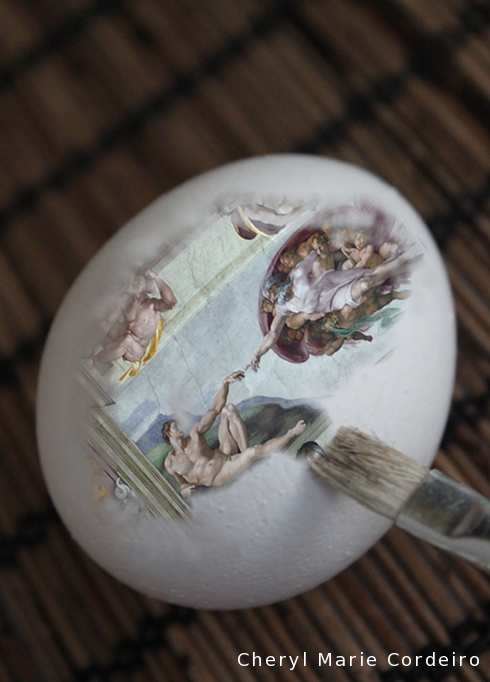
Art class: Easter Egg decorating techniques got really advanced this year.
Easter in Singapore in primary school was also marked by the annual Easter Egg hunt in mid-morning recess!
Teachers at the convent where I grew up would paint and hide hard boiled eggs, perhaps as many as ten eggs, in a small cordoned off garden that was situated between a rectangle of classrooms. This garden in particular, had low cultivated fruit trees, where girls could climb up and sit if they wished, though we were never encouraged to behave in such tomboyish ways.
I think I only ever picked up one Easter Egg in my years in primary school on such egg hunts. I remember spotting several pretty eggs, but never tried to pick them up as ‘prizes’, always preferring to watch as someone else picked it up and what delight she got from having that egg in her hands. Priceless.
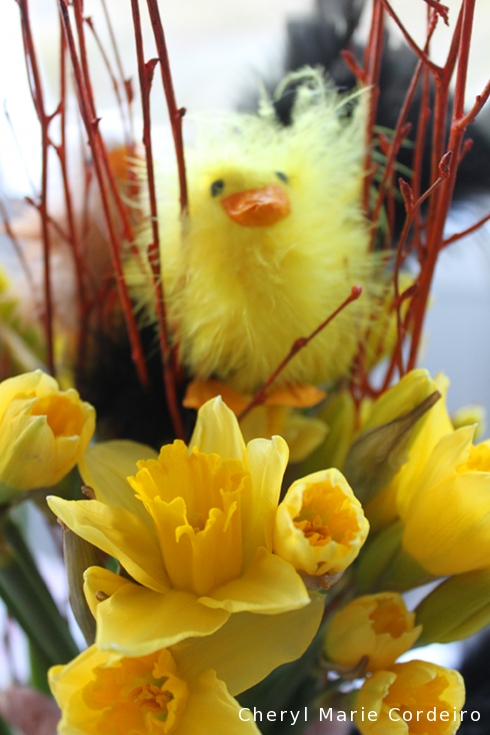
Easter Lilies.
I remember that closed garden fondly because while it was surrounded by classrooms, very few girls would choose to spend their recess time playing in that garden, preferring instead to play in the large field adjacent to the school canteen.
Wonderful memories from school days at the convent, in Singapore.
From the Swedish west coast, Glad Påsk 2013!